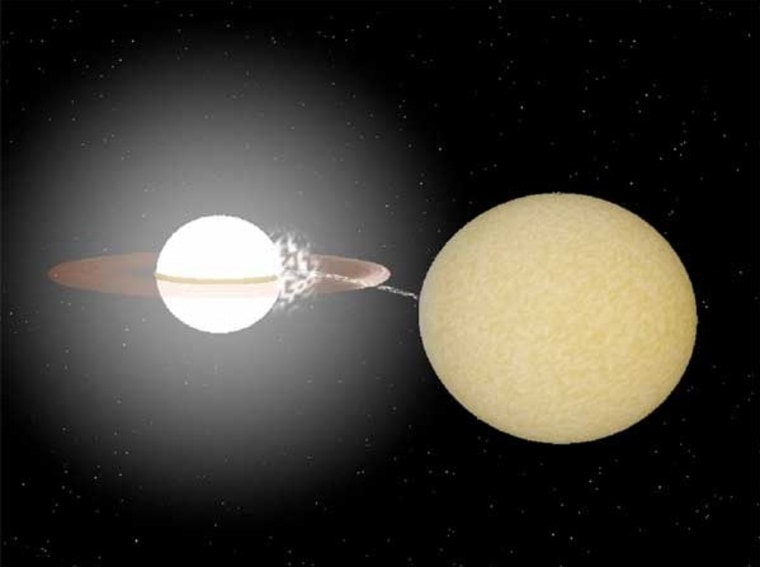After a decade of mystery, astronomers have now shown that a pair of white dwarf stars spin around each other in just 5.4 minutes, making them the fastest-orbiting and tightest binary star system ever found, the researchers claim.
The record-setting stellar duo, known as HM Cancri or RX J0806.3+1527, offer challenges in explaining how such a system might form. The super-quick stars may also present a great future test-bed for detecting gravitational waves, which are elusive ripples in space-time.
Researchers say the stars in HM Cancri are so near to one another — about a quarter of the distance between the Earth and the moon — that they could not get much closer without smushing together.
"A five-minute orbit is about as close as two white dwarf stars can get without merging," said Danny Steeghs, an astrophysicist at the University of Warwick, and co-author of a new paper describing the results.
Dying stars
White dwarfs are the white-hot cores left over from stars that have sloughed off their outer, cooler layers while aging several billion years longer than our sun.
Paradoxically, smaller white dwarfs are more massive than bigger, puffier white dwarfs, given these stars' extreme densities.
In the case of HM Cancri, this phenomenon has led to the smaller, though heavier star gravitationally stealing matter from its nearby companion. A ring of gas has likely formed around the smaller star, while altering the appearance of the donor dwarf.
"The more massive star is distorting the shape of the lighter one into that of a pear, or a raindrop structure," said paper co-author Arne Rau, a post-doctoral researcher in astrophysics at the Max-Planck Institute for Extra-Terrestrial Physics in Germany.
Matter striking the heavier star unleashes bursts of light and energy, which is what first drew astronomers' attention to HM Cancri more than 10 years ago. This periodic brightening as the stars revolve about each other implied the astounding 5.4 minute orbital period, which astronomers initially were at a loss to explain.
Several alternative scenarios about HM Cancri, such as magnetic field interactions of more typically spaced-out, slower dwarfs, had been proposed over the years. Bad weather had scuttled many previous attempts to get a sharper look at HM Cancri.
Upon closer inspection
To finally nail down the orbital period, an international team of astronomers made fresh, clear observations of the stellar duo last year with the Keck I telescope atop Mauna Kea, Hawaii.
The new, detailed spectroscopic measurements showed a shift in HM Cancri's light that fits with the model of two stars whirling around each other nearly every five minutes. (By the time one finishes reading this article, the pair will have made a furious revolution.) The next fastest-orbiting pair comes in at a comparatively slow-poke 9.6 minutes, almost twice as long. (For comparison, Earth takes a year to go around the sun.)
Simon Albrecht, a postdoctoral researcher at MIT who studies binary star systems but was not involved in this research, says he finds the data analysis "thorough," though researchers have had to make a few assumptions about the nature of the HM Cancri system.
Exactly how HM Cancri got to look the way the paper's authors think it does now remains rather puzzling, said Steeghs. The stars that smoldered down into HM Cancri's white dwarfs must have initially been much farther apart, given how little space remains between them now.
Two stars similar to our sun, yet with one initially about twice as massive as the other must have ended up having their life cycles timed so that this evolution could occur, Steeghs said. Further study of HM Cancri may inform models of how binaries interact with each other over lifetimes that last billions of years.
Gravitational wave maker
In any case, as they have wound closer and continue along at their current breakneck pace, HM Cancri's stars should shed energy in the form of gravitational waves. These ripples in space-time were first predicted by Albert Einstein as part of his general theory of relativity in 1915, but have yet to be directly detected.
Given HM Cancri's properties and relative closeness within the Milky Way galaxy, Rau thinks the two quick stars' gravitational waves will be right in the range of frequencies detectable by the space-based Laser Interferometer Space Antenna (LISA), set to launch later this decade.
"HM Cancri has the shortest orbital period we know, and is therefore the most interesting system to find gravitational waves," Rau told SPACE.com.
